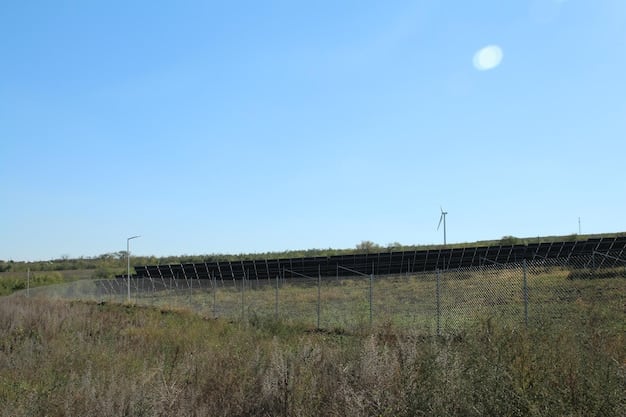Trump’s Climate Policies: Impact on US Businesses & Environment

The Trump Administration’s policies on climate change involved withdrawing from international agreements and easing environmental regulations, leading to both potential short-term economic gains for some US businesses and significant long-term implications for the environment.
The landscape of US environmental policy experienced a dramatic shift under the Trump Administration’s policies on climate change: What are the Implications for US Businesses and the Environment? The decisions made during this period continue to shape discussions around sustainability, economic growth, and international cooperation.
The Paris Agreement Withdrawal
One of the most significant actions taken by the Trump Administration was the withdrawal of the United States from the Paris Agreement. This international accord, signed by nearly 200 nations, aims to limit global warming by reducing greenhouse gas emissions.
The decision to withdraw had ripple effects across the US economy and its relationship with the global community.
Reasons for Withdrawal
The Trump Administration cited concerns about the economic burden on US businesses as the primary reason for withdrawing from the Paris Agreement. It argued that the agreement would put the US at a disadvantage compared to other countries, particularly in sectors like manufacturing and energy.
- Economic competitiveness
- Loss of jobs in certain industries
- Unfair burden on American taxpayers
This perspective resonated with certain segments of the business community, particularly those reliant on fossil fuels. However, many other businesses expressed disappointment, emphasizing the importance of global cooperation on climate change.

Easing Environmental Regulations
Alongside the Paris Agreement withdrawal, the Trump Administration rolled back or weakened numerous environmental regulations. These regulations had been designed to reduce pollution, promote clean energy, and protect natural resources.
The impact of these changes was felt across various industries and environmental sectors.
Key Regulatory Rollbacks
Several key regulations faced significant changes or outright elimination. These included the Clean Power Plan, which aimed to reduce emissions from power plants, and rules protecting wetlands and waterways.
- Weakening of methane emissions standards
- Reduced protections for endangered species
- Easing of fuel efficiency standards for vehicles
These rollbacks were often framed as efforts to boost economic growth and reduce regulatory burdens on businesses. However, environmental groups and some scientists warned about the potential negative consequences for public health and the environment.
Impacts on US Businesses
The **Trump Administration’s policies on climate change: What are the Implications for US Businesses and the Environment?** fostered a complex and often conflicting landscape for US businesses. Some industries thrived, while others faced new challenges.
The short-term economic benefits of deregulation were often weighed against the long-term risks of climate change.
Beneficiaries of Deregulation
Industries reliant on fossil fuels, such as coal and oil, generally benefited from the easing of environmental regulations. These companies faced fewer restrictions on their operations, leading to increased production and potentially higher profits.
Construction and manufacturing sectors also saw some gains from reduced regulatory burdens.
Challenges for Renewable Energy
In contrast, the renewable energy sector faced significant headwinds. While the industry continued to grow, it faced increased competition from cheaper fossil fuels and a less supportive policy environment.

Environmental Consequences
Environmental Consequences
The environmental consequences of the Trump Administration’s climate policies were a major concern for scientists and environmental advocates. The rollback of regulations and withdrawal from international agreements raised fears about increased pollution and accelerated climate change.
The effects of these policies will likely be felt for years to come.
Increased Greenhouse Gas Emissions, Loss of Biodiversity, and Increased Pollution and Impact on Public Health are some of the risks.
While efforts to quantify the exact impacts are ongoing, scientists point to several potential indicators of environmental degradation such as air quality and resource management
The Role of State and Local Governments
In response to the Trump Administration’s policies, many state and local governments took action to address climate change. These efforts aimed to fill the void left by the federal government and demonstrate a commitment to environmental sustainability.
The actions of these subnational actors played a crucial role in maintaining momentum on climate action.
- California’s leadership in clean energy
- Regional climate initiatives
- City-level sustainability programs
These initiatives often faced challenges in terms of funding and enforcement, but they served as important examples of climate leadership and innovation.
International Reactions and Implications
The Trump Administration’s stance on climate change drew strong reactions from the international community. Many countries expressed concern about the US’s withdrawal from the Paris Agreement and the potential impact on global efforts to combat climate change.
This shift in US policy had significant implications for international relations and cooperation.
Strained International Relations
The US’s withdrawal from the Paris Agreement strained relationships with key allies, particularly those in Europe. These countries viewed climate change as a serious threat and criticized the US for abandoning its commitments.
Reduced US influence, altered dynamics in climate negotiations, and challenges to global climate governance are the overall effects of this action.
The Future of US Climate Policy
The **Trump Administration’s policies on climate change: What are the Implications for US Businesses and the Environment?** set the stage for ongoing debates about the future of US climate policy. The Biden Administration has since rejoined the Paris Agreement and pledged to take more aggressive action on climate change.
The future direction of US climate policy remains uncertain.
| Key Aspect | Brief Description |
|---|---|
| 🌍 Paris Agreement | US withdrew, citing economic burden, impacting global climate efforts. |
| 🏭 Deregulation | Easing of environmental rules, benefiting some industries but raising environmental concerns. |
| ⚡ Renewable Energy | Faced challenges due to fossil fuel competition and less supportive policies. |
| 🏛️ State Actions | States and cities took their own climate initiatives, showing continued commitment. |
Frequently Asked Questions
▼
The Trump Administration withdrew primarily due to concerns about the economic burden on US businesses and the belief that it would disadvantage the US compared to other nations.
▼
Key rollbacks included the Clean Power Plan, methane emissions standards, and protections for wetlands and waterways, among others, aiming to reduce regulatory burdens on businesses.
▼
Some industries, like fossil fuels, benefited from deregulation, while renewable energy faced challenges due to increased competition and a less supportive policy environment.
▼
Potential consequences included increased greenhouse gas emissions, loss of biodiversity, and increased pollution, raising public health and environmental concerns among scientists.
▼
Many state and local governments took independent action to address climate change, aiming to fill the void left by the federal government and demonstrate their commitment to sustainability.
Conclusion
The Trump Administration’s climate policies marked a significant departure from previous approaches, prioritizing economic deregulation over environmental protection. While some industries experienced short-term gains, the long-term implications for the environment and the US’s role in global climate action remain significant. The future of US climate policy will likely involve ongoing debates about balancing economic growth with environmental sustainability.





